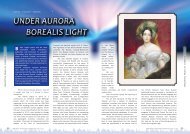i LoVe YoU, Peter'S Great Creation…
i LoVe YoU, Peter'S Great Creation…
i LoVe YoU, Peter'S Great Creation…
You also want an ePaper? Increase the reach of your titles
YUMPU automatically turns print PDFs into web optimized ePapers that Google loves.
RussiaI LOVE YOU,PETER’S GREATCREATION…Leafing through voluminous recordsof the 290-year-old PeterhofCULTURAL HERITAGECULTURAL HERITAGE…It was the third year since the foundingof Petersburg. A cold north wind wasbellying the sails of a two-mast vesselplying the waters of the Gulf of Finland. Itslowed down, an order sounded and thevessel anchored near a small settlement ona desolate coast. It was a suitable place toset up a residence for the tsar who oftentraveled from Petersburg to Kronshtadt. Tokeep with the vogue of those days, Peter’srecreation grounds were called Peterhofwhich translates from German as Peter’s yard.Founded in the early 18th century by Peter Inear the new capital in northern Russia,Peterhof had to become the most luxurioussummer residence, according to the tsar’s plans.Historians and contemporaries acknowledged thatthe project works were running at a stunning rate.The Peterhof opening ceremony was held as earlyas August 1723 (290 years ago). By that time, theLower Gardens had been planned, the MarineCanal had been dug out, some of the fountainswere working, upper chambers had been finished ,and the Monplaisir and Marly Palaces had beenbuilt. The name Marly is associated with Peter I’smemories of his visit to Versailles in 1717, wherehe saw Louis XIV’s residence Marly-Le-Roi nearthe River Seine, decorated with fountains and106 AMBER BRIDGE. INTERNATIONAL NEWSMAGAZINE. 2013. № 3 (11) AMBER BRIDGE. INTERNATIONAL NEWSMAGAZINE. 2013. № 3 (11) 107
CULTURAL HERITAGEcascades. It offered a strong incentive to turn thetsar’s maritime residence into a town of fountains.By the mid-1720s, the 15-hectare UpperGardens and the 102.5-hectare Lower Gardenshad been laid out. The Grand Palace had beenbuilt, the world’s largest system of fountains andwaterworks had been created and much ofsculpture work had been completed with lead andgilded statues, bas reliefs, mascarons and vases. In1799-1806, the lead statues were replaced withgilded bronze copies.According to Peter’s idea, Peterhof, on theone hand, had to rival the luxury of the mostfamous royal residences in Europe, and, on theother, become a triumphal monument to Russia’ssuccessful bid to gain access to the Baltic Sea.Both objectives were brilliantly realized.Art historians note that the Peterhofcomplex blends the regularity and symmetry ofgeneral composition with a skilled use of naturalterrain and variety of design patterns for parksectors, pavilions and fountains.A local legend has it that there were twoFinnish villages – Pohjaoki and Kuusoja - in theplace now occupied by Peterhof. Peter I selectedupland between them and built a small “travel” palace.The tsar built it in a Dutch fashion and named itMonplaisir . There were refreshment rooms, a dininghall, cavaliers’ quarters, a sauna and the tsar’sbath near the palace. A field church was put up inone of the wings.Peter I chose the site for the palace himselfand drew its first sketches.Johann Braustein was the first architect whoproduced the general plan and began to implementit. Jean-Baptiste Alexandre Le Blond, anotherEuropean celebrity, worked on the Peterhof projectfor some time before his death in 1719.Local lore experts and historians agree thatit was on August 15, 1723 that Peterhof wasopened. On that day, Peter I invited foreignambassadors and threw a grand reception. Theresidence clearly symbolized Russia’sbreakthrough to the sea and the end of the NorthWar. The seashore residence appeared as if bymagic to rival the grandeur of the famed royalparks in France, Germany and Italy. It amazedEurope no less than Petersburg. Back then, theforeign ambassadors treated Peterhof asa new miracle of art.… The palace sits on a small capejutting out into the gulf. Sixteen fullyglassed wooden arcs of the galleries lendit transparency and lightness. The galleriescan be used for walks and offer an excellentview of the sea and the gardenwith fountains. The walls of each galleryhave niches for 23 paintings. Peter I wasparticularly fond of seascapes. In fact, it isthe first picture gallery in Russia, the precursorof the famous Hermitage.The very name of the palaceindicates how the tsar felt about it. Heloved his brainchild and cared for itzealously. Monplaisir was the venue of manyofficial receptions. Peter I liked to rest watchingmen-of-war and merchant ships sailing across theGulf. The palace looks modest and graceful at thesame time. The architects who built Monplaisirunder Peter’s personal supervision lent it graceand lightness, without burdening the exterior withpomposity or unnecessary elements. Numerousarcade doors lend it festive appearance. Thebuilding is noted for simple design, surprisinglightness and clear proportions. Characteristically,the architectural solution for the structure naturallyintegrates it in the local landscape.The tsar had the idea to build a Baltic versionof Versailles in 1714. Two years later, he orderedhis envoy in Paris to send him Versailles blueprints.The blueprints and drawings were delivered, but theproject manager was missing. Peter invited Jean-Baptiste Alexandre Le Blond, a Versailles architect.He took part in the construction of the UpperChambers and the wooden palace in Strelnya. Thetsar closely watched the construction, issued instructionson installing amusements, fountains, andgarden lay-out, and made drawings himself.During his frequent travels abroad, Peter Ibought decorations for palaces, paintings andfurniture and ordered many rare saplings for hisgardens. He personally wrote interior andfurnishing instructions for palace chambers. Heeven launched fountains himself when he showedthem to his guests.In his palace, the Emperor looked like an ordinarylandlord. He never missed the smallest detailin Peterhof maintenance, and liked showing hisguests how trick fountainsworked. Walks ingardens and sightseeingtours required Peter’spermission. Hesometimes assigned aguide to his guests,but often preferredshowing the wondersand surprises of hisentertainment palacehimself.Benches withtrick fountains wereinstalled in the Monplaisirgarden. A visitorwho took a seat got sprayed with water, an everwelcome occasion for merriment for the tsar andhis large entourage. The Peterhof fountains are theonly operating 17th and 18th century water jokes.Peterhof often played host to assemblies.The tsar’s decree introducing the novelty explainedthat “assembly” was a French word meaning “agroup of people who gathered for entertainment,discussion or friendly talk.” The invitees were selectpersons: senior officers, the gentry, officials, shipbuilders,rich merchants and scientists. As a rule,they came with their wives. The socializing began at17:00, and ended at 22:00. Special tables were setfor chess and checkers players. Peter I liked chessand played it well.The ease and small talk skills did to come toassembly guests at once. The first balls of the PeterI’s epoch were oppressively boring, with guestsCULTURAL HERITAGE108 AMBER BRIDGE. INTERNATIONAL NEWSMAGAZINE. 2013. № 3 (11) AMBER BRIDGE. INTERNATIONAL NEWSMAGAZINE. 2013. № 3 (11) 109
CULTURAL HERITAGEfearing to make a move lest they should evoke thetsar’s displeasure. Dancing was treated as unwelcomecompulsory service with stony faces andclumsy footwork. Getting a conversation goingwas difficult too, with curt replies and long pauses.A contemporary wrote about one such assembly:“ladies always sit separately from men, so talkingwith them is not only impossible, you can hardlysay a word; when nobody is dancing, everybodysits as if dumb, they are just looking at each other.”And yet assemblies were a new form ofsocializing: they were largely meant to put an endto the secluded life of women. For the first time,women left their reclusive chambers to appear inthe society.… After Peter I’s death, the finishing of the picturegallery was completed in 1726, and the Eve andGreenhouse fountains were installed. But then, opponentsto Peter’s reforms got the upper hand and Peterhofstood nearly forgotten for four years. It becamerundown as the royal court moved to Moscow.wrote in 1925: “Russia elected Zemtsov, a truePeterhof creator, who realized the most advancedideas in art which were on the minds of Parisianmasters, although these ideas were neverunderstood or used elsewhere in Europe, exceptParis and Peterhof.”Beginning from the first quarter of the 18thcentury, Peterhof parks accommodated grandfestivals in commemoration of Victory Days andName Days for members of the royal family. Thefestivities were famous throughout Europe forgrand illumination and fireworks and attracted the“whole Petersburg.” Well-known contemporaryartists, including Mikhail Negubov and IvanVeishnyakov, were hired to paint illuminated sitesduring such festivals.The festivals were held on especially grandscale in the 1830s – 1850s, when outdoor performanceswere given in the Lower Gardens. In thesecond half of 19th century, the authorities openedthe park grounds for public festivals with illumina-terhof, Elizabeth indulged in rare pleasures of privatelife, cooking in the Monplaisir kitchen byherself, tending a garden and inspecting storerooms.She preferred spending time in Monplaisirwhere everything reminded her about her father.But the cheerful Empresscould not content herselfwith such modest quarters.The Upper Chambers were enlargedfor the royal Court byattaching side galleries, theCoat-of-Arms Block and St Peterand Paul Church. The workswere directed by BartolomeoFrancesco Rastrelli. A fencewas built around the UpperGarden and a magnificent entrance gate was added.The Samson Canal was dug out, and woodenpipes were replaced with cast iron ones. AlthoughCatherine II chose Tsarskoye Selo for her summerresidence, she did not forget Peterhof and evenplanned to link it with St Petersburg Canal. The projecthowever was never implemented. Instead, aroad was built, one of the first in Russia.The names of Catherine II and her maid ofhonor Yekaterina Dashkova are also associated withshore, but on windy days, she retreated to the flowergarden on the other side of the gallery.Peterhof was a source of inspiration for manyRussian poets, writers and musicians. AlexanderPushkin first visited it on July 1, 1818, for the birthdatecelebrations of GrandDuchess Alexandra Fyodorovna.The wonderful scenery ofPeterhof, the fabulous grandeurof its parks, fountains and palacesmade a powerful impressionon the young poet. Delightedwith their splendor, hedescribed the festivity in hispoem Ruslan and Lyudmila.Critics acknowledge that thepoem, from the dedication to the epilogue, carriedthrough the substance of the impressions from thePeterhof reception which the poet had attended:<strong>Great</strong> fountains upward, to the sky,Send sprays of gems, then down, enwreathingThe statues that, alive and breathing,Around them stand. If Phidias' eyeOn these could rest, he, though by PallasAnd by Apollo taught, would, jealous,His magic point and chisel drop....In swift and fiery arcs that shatter'Gainst marble barriers which stopTheir headlong downward plunge and scatterThe tiny motes of pearly dust,The waterfalls cascade, while justA few steps farther out, in nooksBy thick trees shadowed, rippling brooksPlash sleepily....CULTURAL HERITAGEPark fences, gardens, magnificent trees,palaces and fountains remember Nekrasov andDostoyevsky, Akhmatova and Brotsky, and manyother Russian belletrists. Poet Mikhail LermontovIt was only in 1730 that Peterhof got a newlease of life, when Empress Anna Ioanovnacontinued the construction. She invited MikhailZemtsov, the first Russian honored with the title ofarchitect. He revised the colonnade design by hiswell-known colleague Nicola Michetti adjusting itfor northern climate and creating a new interestingcomposition. He also worked on the Grand andMarly Cascades and fountains along the GrandCanal. Well-known art historian Vladimir Kurbatovtion, fireworks and lottery. Billboardswere posted in Petersburg to informthe residents about festival dates.When Peter I’s daughter Elizabethascended the throne in 1741, Peterhofregained the status of personalresidence and recreation center for the select. Elizabethcherished her father’s memory; it was duringher reign that many of Peter I’s undertakings, suspendedby his predecessors, were resumed. In Pe-Peterhof. They were close friends, confidantes, andexpert horse riders. When the Empress came to Peterhof,she always stayed at Monplaisir and usuallyworked on the Palace veranda that faces the sea-visited the place too. The Sail, one of his mostfamous poems, was written near the MonplaisirPalace on the shore of the Gulf of Finland.Marking a jubilee of its service to Russia,Peterhof remains a guardian of the memory ofmany historic events and persons from the400-year-old biography of the House of Romanov.Andrei Karavaev,for Amber Bridge110 AMBER BRIDGE. INTERNATIONAL NEWSMAGAZINE. 2013. № 3 (11) AMBER BRIDGE. INTERNATIONAL NEWSMAGAZINE. 2013. № 3 (11) 111







